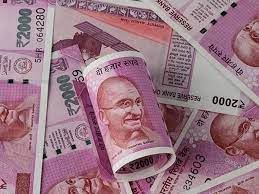
Recently, there has been an announcement by the government as per which another Indian currency denomination is going to be withdrawn from circulation; the highest banknote Rs 2,000 which will not be issued by banks anymore. The RBI has instructed the banks to help customers in exchanging their Rs 2,000 notes or deposits in this denomination. The news has attracted lot of criticism from the Opposition. The Congress has criticized the government for announcing the sudden scrapping of Rs 2,000 notes. Congress Chief Mallikarjun Kharge also took a shot at the ruling government by saying that whenever PM Modi goes to Japan, there is a “notebandi” notification—a reference to the 2016 demonetisation. There was much chaos in the country after the first demonetisation, whereby the entire unorganised sector was badly affected, many MSMEs were forced to close down and crores of jobs were lost. However, the withdrawal of Rs 2,000 notes is expected to create some issues, though not major ones.
A History of the Pink Note
The Rs 2000 note was brought into circulation in November 2016, primarily with the aim of meeting the currency requirement of the economy after the Rs 500 and Rs 1000 notes were pulled out of the market. With the fulfilment of that objective, and once notes of other denominations were available in adequate quantities, the printing of Rs 2000 notes was stopped in 2018-19. The RBI issued the majority of the Rs 2000 notes before March 2017 and these notes have now completed their estimated lifespan of 4-5 years and are no longer commonly used for transactions. It is also important to pay attention to the Clean Note Policy that seeks to give the public good quality currency notes and coins with better security features, while soiled notes are withdrawn out of circulation. The RBI had earlier decided to withdraw from circulation all banknotes issued prior to 2005 as they have fewer security features compared to banknotes printed after 2005. Be that as it may, the notes generated before 2005 keep on having legal tender. They have just been removed from flow in congruity with the standard terms of not having notes of numerous series available for use simultaneously. According to the assertions from RBI, the Rs 2000 banknote will continue to keep its lawful status and the public can keep on involving Rs 2000 banknotes for their exchanges, and furthermore get them in instalment, but individuals are urged to deposit or exchange these banknotes at the latest by 30 September 2023. The RBI and the government are of the view that it is far-fetched that bank offices will observe tumult and long lines like in 2016 this time. The printing of Rs 2000 notes was halted in 2018-19, and they are not generally regularly seen with general society, not at all like the common Rs 500 and Rs 1000 notes in 2016. Likewise, the choice to pull out Rs 500 and Rs 1000 notes was reported unexpectedly, overwhelming people in general. This time, banks and the general population have adequate time to exchange the trade Rs 2000 notes.
Withdrawal implications
RBI Governor Shaktikanta Das has said that the entire process of withdrawal of the high-denomination currency will be non-disruptive, as these notes had completed the lifecycle and the purpose has been fulfilled and RBI has given four-month time for exchanging as well as depositing the Rs 2,000 currency notes to ensure that there is no hardship faced by anyone. Taking into account the effect on the economy, it tends to be conjectured that the impacts will be impermanent, with RBI giving clear rules and FAQs, there is expected to be reduced panic compared to the 2016 demonetisation. The expanded reception of digital exchanges will assist with limiting interruptions for people intensely dependent on cash exchanges. However, there will be a recognisable decrease in the general cash circulation. The choice to cease printing these notes was expected as RBI had not printed new 2000 rupee notes beginning around 2019. There have been sure off course influences. After the withdrawal was reported, Indian expatriates and tourists in the Gulf, including the UAE, are finding it tough to exchange the notes they hold. This is on the grounds that the cash exchanges are declining to manage the withdrawn money. While Indians are feeling the spot of RBI’s choice in a far-off country, cash exchangers said that the clients are not generally ready to purchase the Rs 2000 notes they hold. All in all, RBI’s choice to transition away from 2000 rupee notes upholds the goals of the “Clean Note Policy”.
While the economy might encounter impermanent impacts, the availability of smaller denominations and the growing digital transactions landscape are expected to mitigate disruptions caused by the reduction in cash circulation.

Sharanpreet Kaur in an Assistant Professor of International Relations at School of Social Sciences, Guru Nanak Dev University, Amritsar. She writes on issues related to India’s foreign policy, diplomacy, and the politics of South, Central and West Asia.